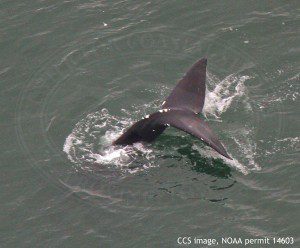February 2015

Right whale EgNo1425, one of last seasons’ moms, shows off her baleen while high skim feeding. CCS image, NOAA permit 14603.
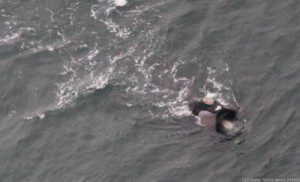
Arpeggio (EgNo2753) gives a good look at her tongue and open mouth while high skim feeding. CCS image, NOAA permit 14603.
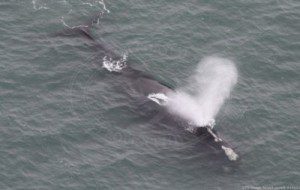
EgNo3405 shows off the right whales characteristic V-shaped blow. CCS image, NOAA permit 14603.
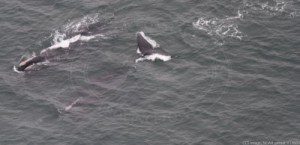
Two right whales, EgNo3823 and a yet unidentified individual, demonstrate “coordinated feeding”. CCS image, NOAA permit 14603.
February 4, 2015: With another impending storm literally on the horizon after the Blizzard Juno, we took off early on this frigid Wednesday in hopes of completing as much of the survey as possible before the wind picked up.
In previous surveys whales were spotted deeper in the bay, so we flew our tracklines in a south to north direction in hopes of resighting them or new individuals. The area of the bay where we last had right whales was surveyed in good conditions but no whales were observed. It’s impossible for us to know if they were there and spending time below the surface, potentially deep subsurface feeding, or just not there at all.
Unfortunately conditions worsened to a degree that we had to cut survey the short, and disappointingly not one marine mammal was observed. There was much conversation in the plane and later in the lab about the effect of these strong storms on the animals themselves and their food sources.
We are looking forward to the next good weather window to get back out there and see some of our seasonal visitors.
February 12, 2015: We have been desperately waiting for the weather window. With high hopes and a very tight frame between the snowfall and gusting wind days, we finally took to the air. We had an early take off, aiming to fly the Cape Cod Bay in the North to South direction. The weather was surprisingly good – even the ocean side sea state wasn’t higher than 3 on the Beaufort scale. In the Bay, the clouds accumulated and it began to snow in the distance, but the visibility stayed good, and we found the right whales! They’re back! We can’t wait to see more and more arriving.
On this flight we spotted and photographed 19 right whales (our record for 2015 – before today was no more than 7 per flight), mostly in clusters of 2 to 4 individuals.
The right whales were deep-diving and subsurface-feeding, but there was also a group skim-feeding on the surface. Some were even high skimming, with much of the baleen up and out of the water. Skim-feeding at this time of year is unusual – it’s a behavior we don’t usually see until later in the season. Interestingly, we did not find any fin whales, which have been prevalent on most of our flights this season.
On our last track-line along the southern coast of the bay the waters were filled with small pieces of ice. We landed with perfect timing as snow began to fall at the airport. A real winter right whale survey!
February 18, 2015: After waiting nearly a week for a good weather window we finally had a chance this overcast Wednesday to fly Cape Cod Bay. There had been two more strong storms in the area over recent days, so we were curious to see how many individual right whales would be sighted and what behaviors would be observed after all the turbulence.
We took off in the afternoon because our runway had to be plowed first – thank you to everyone at Chatham airport and the Town of Chatham Department of Public Works for helping to get us up and out over the Bay! The later departure also gave let the winds die down as predicted.
The survey started off slow, with no whales on the backside and the northern portion of the bay. Finally, off of Wellfleet, about a third of the way through survey, Brigid called a ‘break track’ and the plane circled back towards the black body she had seen. After circling for almost 10 minutes the water finally rippled and a right whale showed itself as Brigid’s first aerial right whale!
Four additional right whales were sighted; all individuals were conspicuous with long dives close to 20 minutes in length. The southern portion of the bay was uncharacteristically frozen over, obscuring some of our lines. We completed all of the transect lines and headed home before the light of a beautiful sunset shone over Chatham with pictures and data successfully procured.
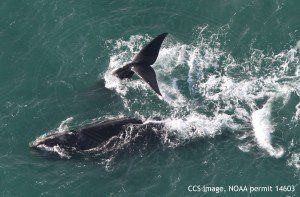
Right whales EgNo 2215 and 2320, who is taking a deep dive). Cape Cod Bay, 2/24/15. CCS Image, NOAA Permit #14603
February 24, 2014: After what seemed like endless onslaught of storms, we were fortunate enough this Tuesday to squeeze in half of a survey in Cape Cod Bay. The skies were clear, with excellent visibility but the winds were high resulting in a dismal sea state. We began the survey on the southern track lines moving in a northern direction, and regardless of the less than optimal sea states we managed to spot 11 right whales. The right whale sightings were located in the central portion of the bay, and they exhibited a variation of behaviors ranging from fluking dives to subsurface feeding.
February 28, 2015: This Saturday flight was welcomed with open arms after an unsuccessful survey the day prior due to unpredicted high sea state conditions. We took off on this beautifully clear and sunny day and began our track lines south to north. The ice we have seen in previous surveys in the southeast corner of the bay persisted. Ten right whales were sighted and most were photographed, which was satisfactory since nearly all were doing long, fluking dives (likely having found food at or near the bottom) and not on the surface for extended periods of time. The distribution in Cape Cod Bay was pretty scattered throughout the bay. The last whale of the day, EgNo 3710 “Eros”, was on the backside off of Wellfleet and exhibited the same behaviors as those inside.

Our Work
Humpback Whale Research
Right Whale Research
Marine Animal Entanglement Response
Marine Geology Department
Water Quality Monitoring Program
Marine Fisheries Research
Seal Research
Shark Research
Marine Education
Interdisciplinary
Marine Debris and Plastics Program
Marine Policy Initiative
Cape Cod Climate Change Collaborative
Publications

